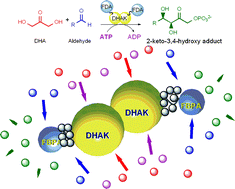Substrate channelling in an engineered bifunctional aldolase/kinase enzyme confers catalytic advantage for C–C bond formation†
Abstract
A new bifunctional enzyme that displays both aldolase and

* Corresponding authors
a
Departamento de Química Orgánica Biológica, Instituto de Química Orgánica General, CSIC, Spain
E-mail:
eduardo.junceda@iqog.csic.es
Fax: +34-915 644 853
Tel: +34-915 622 900
A new bifunctional enzyme that displays both aldolase and

 Please wait while we load your content...
Something went wrong. Try again?
Please wait while we load your content...
Something went wrong. Try again?
L. Iturrate, I. Sánchez-Moreno, E. G. Doyagüez and E. García-Junceda, Chem. Commun., 2009, 1721 DOI: 10.1039/B822345A
To request permission to reproduce material from this article, please go to the Copyright Clearance Center request page.
If you are an author contributing to an RSC publication, you do not need to request permission provided correct acknowledgement is given.
If you are the author of this article, you do not need to request permission to reproduce figures and diagrams provided correct acknowledgement is given. If you want to reproduce the whole article in a third-party publication (excluding your thesis/dissertation for which permission is not required) please go to the Copyright Clearance Center request page.
Read more about how to correctly acknowledge RSC content.
 Fetching data from CrossRef.
Fetching data from CrossRef.
This may take some time to load.
Loading related content
